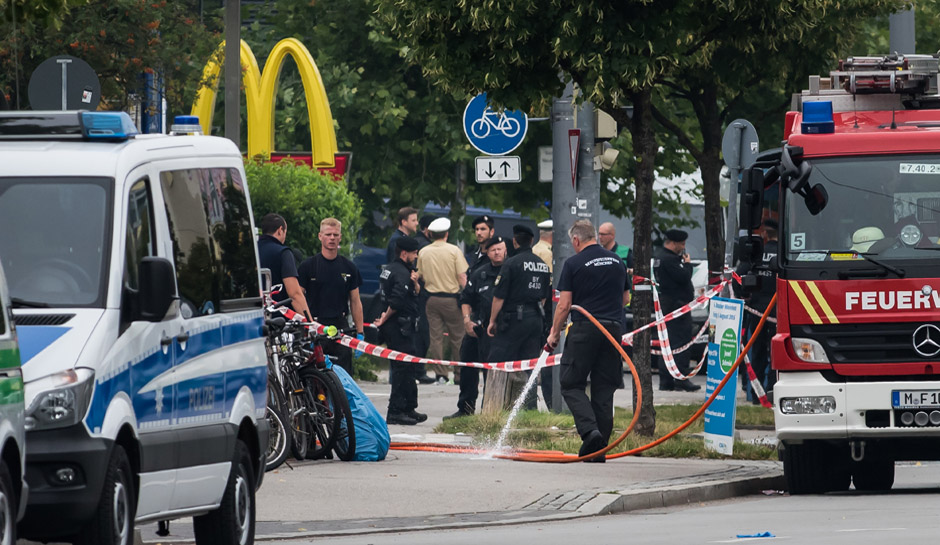The Man Behind The Munich Shooting

NEW DELHI: A gunman killed nine people and injured 16 others in a shopping district in Munich on Friday. In Europe, that’s on high alert following a string of attacks, the gunman’s identity -- that of Iranian origin -- was enough to label the attack a “terror” attack. No group has claimed responsibility for the attack.
Just a few days before, a teenager stabbed passengers on a German train. The attack was again, quickly linked to the Islamic State, perhaps because a flag -- similar to ones used by the group -- was found. ISIS was quick to claim the attack, but no evidence has been found that the man in question was acting in accordance with instructions from the Syria-based group.
In Friday’s attack, no such black flag was found, forcing us to delve into the person behind the attack instead of quickly labelling it an ISIS terror attack and moving on.
What emerges as we peer into the life and thoughts of the 18 year old attacker is the picture of a deranged lone gunman obsessed with mass killings. Seven of his victims were teenagers themselves, lured to their deaths via a hacked Facebook account on what was the fifth anniversary of twin attacks by Norwegian mass murderer Anders Breivik that killed 77 people.
Reuters quotes Bavarian state crime office president Robert Heimberger saying that the gunman, who German media named as Ali David Sonboly, was carrying more than 300 bullets in his backpack and pistol when he shot himself. Munich police witnessed the suicide at 8:30 p.m. local time (1830 GMT), the police force said on Saturday.
Chancellor Angela Merkel said on Saturday that Munich had suffered "a night of horror". "A night like this is difficult for us all to bear," she said. Speaking from her office in Berlin, the German leader added: "All of us, and I say this on behalf of the whole government, are mourning with heavy hearts those who will never be able to return to their families."
A search of the attacker’s room revealed a book on teenage shooting sprees. "Documents on shooting sprees were found, so the perpetrator obviously researched this subject intensively,” Munich police chief Hubertus Andrae said. The gunman was born and brought up in the Munich area and had spent time in psychiatric care, and there was no evidence to suggest he had had an accomplice, Andrae said.
The gunman, it seems, had used a profile with the name Selina Akim - an actual person he hacked - promising free food and luring victims to their deaths. He was last seen online merely hours before the attack. "I can buy you something that's not too expensive," the shooter wrote -- offering potential victims free food at McDonald’s.
"There has been a suggestion that this individual, the perpetrator, had tried to lure people to that fast food restaurant with the promise that he will buy food for them," said Al Jazeera's Dominic Kane. "He clearly wanted them to go to where he could shoot at them."
The attack clearly had a lot more in common with mass shootings than with terror. But if a black flag had been found on the attacker, would anything else even matter?
Remember, the train attack was labelled a terror attack without any proof of links with a terror group. A black flag and a homemade video that threatened “infidels” were enough to make that claim. In fact, even authorities admit the attacker was a “lone wolf” -- i.e., acting alone without coordination with the parent group. The absence of a black flag is forcing us to delve into the mental and personal life of the attacker. The German train attacker perhaps has far more in common with the Munich attacker than with militants fighting in Syria and Iraq under the banner of the Islamic State. But why should that matter if a black flag was found?
Perhaps George Brandis sums up my point better. The attorney general said, in the aftermath of the attack, that the word “terrorism” should not be used so loosely. “It’s very important to be careful in our use of language,” Brandis told the ABC’s Insiders program on Sunday. “Not every mass casualty attack is an act of terrorism. Not every premeditated act of violence is an act of terrorism.
“Our law has a very specific definition of terrorism. Terrorism is an act of violence or a threat of violence perpetrated for a political, religious or ideological cause, to coerce government or to intimidate the public. If we’re going to understand this problem we have to anatomise it correctly. We must be very careful in our use of language so that we don’t spray the word terrorism around too loosely.”
Brandis also said events such as the shooting in Munich were very difficult to predict and lone gunman who self-radicalise are “the most difficult people to pick up.”
“One of the phenomena that we have seen develop more recently is the development of lone actors who self-radicalise, often very quickly, most commonly online,” he said. “Very frequently these are young men with psychological disturbances, they don’t fit into the conventional or traditional understanding of a terrorism network.”
Unfortunately, all it takes is a black flag to dispense off the role of “psychological disturbances.”



